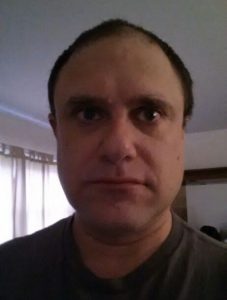Not Just A Woman’s Issue: Charles’s Battle With An Eating Disorder
 This two-part article was written exclusively for EatingDisorders.com by Charles Friedman, creator of the blog Every Bodies Beautiful Image. In this article, Charles talks about his struggles with depression, ADHD and an eating disorder as well as how his son has made a positive impact on his life.
This two-part article was written exclusively for EatingDisorders.com by Charles Friedman, creator of the blog Every Bodies Beautiful Image. In this article, Charles talks about his struggles with depression, ADHD and an eating disorder as well as how his son has made a positive impact on his life.
My problems started manifesting themselves with wildly uncontrollable behavior. It was at the time determined that some psychological disturbance was the root cause and I was placed on Ritalin. Upon entering kindergarten I was placed in a special education program based on my behavior and not my ability to learn, when the school finally made the realization that they had made an error it was too late for me. I was already stigmatized that there was something wrong with me. I felt that I was different in some way from the other kids my age. In third grade my impulse control and my outbursts increased although academically I was moving at a very rapid pace.
In 1982 my parents had left me with a babysitter who decided to meet his friend at the movies to see Rocky 3 and to take me along. We went, getting there late and had caused the two teenage boys to miss the movie. They spent the time throwing candy at me and putting snot in my hair. Upon returning to my house afterward the babysitter’s friend beat me up. I guess you never forget when the abuse starts. My parents didn’t believe me when I told them. Shortly thereafter my family moved to another town and things just got worse.
Bullying Takes its Toll
By the time I entered middle school I was a psychological mess. I was ostracized and cast aside by my classmates whose parents told them not to associate with me because I was a bad child. My nickname was “Charlie no friends” or just “no friends.” I was told I was a psycho, crazy, a loser, incorrigible, and a few other words. I wasn’t invited to parties, to hang out, to do anything. I spent most of my time on the couch in my parents’ living room watching television.
When I was 14 I was at the local YMCA where I was sexually molested in the locker room by a stranger. When I told the staff they didn’t believe me, and neither did my parents. I never went back there again. I grew more and more depressed as time went on and eventually stopped eating breakfast and lunch during the week. No one questioned this or used the term “eating disorder” because boys don’t have those; that is a girl problem.
By 16 I was 5 feet 6 inches tall and weighed 115 pounds. My outbursts in school were getting worse, and people were pulling further away from me. I had made a friend during my freshmen year in high school, but when her friends questioned her association with me she stopped talking to me. I was hurt, angry, depressed and eventually suicidal. My impulse control was still unchecked and was getting worse, as were my now violent outbursts. Finally I couldn’t take it anymore; I walked into my guidance counselor’s office and told her I would see her on the other side, and then I walked out of the school to go home and end my pain. The cops were called, and they took me back to the school until I was picked up by an uncle.
Getting Evaluated and Diagnosed
I went to an alternative high school where still unchecked my behavior, the inappropriate statements, and other anti-social symptoms kept me from developing any type of social interaction. I was taken to be evaluated by a team of psychologists who determined that I had severe clinical depression, and for the first time the term ADHD was used. What’s odd is despite my eating habits hadn’t improved and I was still around 120 pounds, the term eating disorder was never applied. I was put on cylert and cogenten and sent on my way.
I graduated high school and started college, which lasted about a year. I had a breakdown that landed me in a psychiatric hospital for nine months and the layers started to peel. The abuse that happened when I was 8, the isolation and rejection by my peers, the sexual abuse, and finally they addressed my eating disorder.
 Eating Disorder Self Test. Take the EAT-26 self test to see if you might have eating disorder symptoms that might require professional evaluation. All answers are confidential.
Eating Disorder Self Test. Take the EAT-26 self test to see if you might have eating disorder symptoms that might require professional evaluation. All answers are confidential.